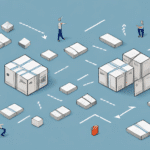Understanding the Costs of Third-Party Logistics (3PL)
If your business relies on transportation and logistics services, you may have considered outsourcing these functions to a third-party logistics (3PL) provider. Outsourcing to a 3PL can streamline operations, free up internal resources, and enhance overall efficiency. However, it's crucial to understand the associated costs to make an informed decision. In this article, we delve into the costs of 3PL and offer strategies to manage and reduce them effectively.
What is Third-Party Logistics (3PL) and Why is it Important?
Third-party logistics (3PL) involves outsourcing transportation and logistics operations to an external provider. According to the Council of Supply Chain Management Professionals (CSCMP), 3PL providers offer services such as transportation management, warehousing, and order fulfillment.
Outsourcing logistics to a 3PL provider can significantly reduce costs, improve operational efficiency, and provide access to specialized resources that may not be available in-house. 3PL providers bring expertise in navigating complex transportation regulations and optimizing supply chain operations, allowing businesses to focus on their core competencies and enhance customer satisfaction and profitability.
Benefits of Outsourcing to a 3PL Provider
Cost Savings
One of the primary advantages of partnering with a 3PL provider is cost reduction. By leveraging the provider's established networks and economies of scale, businesses can decrease transportation and storage expenses, as well as labor costs associated with logistics management. According to a study by Forbes, businesses can save up to 20% on logistics costs by utilizing 3PL services.
Improved Efficiency
3PL providers utilize advanced technology and streamlined processes to enhance supply chain efficiency. They offer services like real-time shipment tracking, inventory management, and data analytics, providing businesses with actionable insights to optimize their operations. This enhanced visibility allows for better decision-making and can lead to faster delivery times and increased customer satisfaction.
Case Studies: Successful Implementations of 3PL Strategies
Numerous companies have successfully leveraged 3PL providers to enhance their logistics operations:
- Walmart: Walmart utilizes a combination of its own assets and 3PL providers to maintain a highly efficient transportation network, reducing costs and improving delivery times.
- Dell: By partnering with 3PL providers, Dell has streamlined its inventory management and accelerated order fulfillment processes, enhancing customer satisfaction.
- Amazon: Amazon leverages 3PL services to manage its vast and complex supply chain, ensuring fast and reliable delivery to millions of customers worldwide.
Types and Selection of 3PL Providers
Types of 3PL Providers
There are four main types of 3PL providers, each offering different services tailored to specific business needs:
- Asset-Based Providers: These providers own their own transportation and storage assets, such as trucks, ships, and warehouses. This ownership allows for greater control over logistics operations and can lead to more reliable service.
- Management-Based Providers: These providers specialize in managing logistics operations for businesses that do not own their own assets. They oversee various aspects of the supply chain, including transportation management and warehouse operations.
- Transport-Based Providers: Focusing primarily on transportation services, these providers offer expertise in route optimization, freight management, and carrier selection to ensure efficient shipment movements.
- Financial-Based Providers: These providers offer financial services related to the supply chain, such as supply chain financing, freight bill auditing, and cost analysis to help businesses manage their logistics budgets effectively.
Factors to Consider When Choosing a 3PL Provider
When selecting a 3PL provider, it's essential to evaluate several factors to ensure the partnership aligns with your business goals:
- Expertise and Experience: Assess the provider's experience in your industry and their ability to handle the specific logistics challenges your business faces.
- Technology Capabilities: Evaluate the technological tools and systems the provider uses, such as warehouse management systems (WMS) and transportation management systems (TMS), to ensure they integrate smoothly with your existing infrastructure.
- Service Range: Consider the range of services offered and whether they meet your current and future logistics needs.
- Geographic Reach: Ensure the provider has a presence in the regions where your business operates to facilitate efficient logistics operations.
- Reputation and References: Research the provider’s reputation through customer reviews and request references to gauge their reliability and service quality.
Cost Factors and Hidden Expenses in 3PL Services
Service Requirements
The range and complexity of services you require directly impact the overall cost of 3PL services. Basic transportation and warehousing services may be more affordable, while value-added services such as packaging, kitting, and reverse logistics can increase expenses. It's important to clearly define your logistics needs to avoid unnecessary costs.
Technology Use
Advanced technologies, including real-time tracking, automated inventory management, and data analytics, can enhance efficiency but may come at a higher cost. Providers that invest in cutting-edge technology often charge premium rates, but the long-term benefits of improved visibility and decision-making capabilities can offset these costs.
Volume and Distance
The volume of goods being transported and the distance of shipments are significant factors affecting 3PL costs. Higher shipment volumes can lead to economies of scale and lower per-unit costs, while longer distances typically incur higher transportation expenses. Additionally, international shipments may involve customs fees and regulatory compliance costs.
Hidden Costs
Some 3PL providers may include hidden costs that are not immediately apparent in their pricing structure. These can include fees for after-hours pickups, storage minimums, and charges for oversized or overweight shipments. It's crucial to thoroughly review the contract and clarify all potential fees to avoid unexpected expenses.
Common Hidden Costs Associated with 3PL Services
In addition to the standard costs outlined in service agreements, businesses should be aware of several hidden costs that may arise when working with a 3PL provider:
- Storage Minimums: Some 3PL providers require a minimum volume of goods to be stored, which can lead to unexpected storage fees if not met.
- After-Hours Fees: Requests for pickups or deliveries outside of regular business hours may incur additional charges.
- Oversized or Overweight Shipments: Handling shipments that exceed standard size or weight limits can result in extra fees.
- Change Fees: Alterations to orders or services after they have been processed may incur modification fees.
- Emergency or Rush Fees: Requests for expedited services to meet tight deadlines can lead to premium pricing.
To mitigate these hidden costs, thoroughly review the 3PL contract, seek transparency in pricing structures, and clearly communicate your logistics needs and expectations.
Calculating and Managing 3PL Costs
Total Cost Calculation
To accurately calculate the total cost of partnering with a 3PL provider, consider the following components:
- Transportation Costs: Fees associated with the movement of goods, including freight charges, fuel surcharges, and carrier fees.
- Warehousing and Handling Fees: Costs for storage, material handling, and labor within the warehouse facilities.
- Value-Added Services: Additional services such as packaging, labeling, kitting, and reverse logistics.
- Technology Fees: Charges for access to advanced systems and real-time tracking tools.
- Contractual Fees: Any fixed fees or long-term commitments outlined in the service agreement.
It's important to create a comprehensive cost breakdown and compare it against your current in-house logistics expenses to determine potential savings.
Strategies to Reduce Logistics Costs with 3PL
Consolidating Shipments
Consolidating shipments is an effective method to lower transportation costs. By bundling multiple orders into a single shipment or opting for less-than-truckload (LTL) shipping, businesses can optimize their freight usage and reduce per-unit transportation expenses. According to Logistics Management, LTL shipping can reduce overall shipping costs by up to 30% compared to full truckload (FTL) shipments.
Inventory Management
Improving inventory management practices can significantly reduce storage costs and minimize excess inventory. Implementing strategies such as just-in-time (JIT) inventory systems, accurate demand forecasting, and automated inventory tracking can lead to more efficient stock levels. Effective inventory management not only lowers warehousing expenses but also improves cash flow and reduces the risk of stockouts or overstock situations.
Optimizing Packaging and Materials
Optimizing packaging can reduce shipping costs by minimizing package sizes and reducing weight. Streamlined packaging not only saves space but also decreases the likelihood of product damage during transit, which can lead to additional costs for returns and replacements.
Continuous Data Analysis
Regularly reviewing and analyzing logistics data helps identify inefficiencies and areas for improvement. Tracking key performance indicators (KPIs) such as transportation costs, delivery times, and order accuracy can inform strategic decisions to optimize logistics operations and reduce costs over time.
Negotiating and Managing Your 3PL Partnership
Negotiating Rates
Effective negotiation can lead to more favorable terms and reduced costs when working with a 3PL provider. Here are some strategies to consider:
- Volume Discounts: Leverage higher shipment volumes to negotiate lower rates. Discuss potential discounts based on projected growth and increased business.
- Flexible Payment Terms: Negotiate payment terms that align with your cash flow, such as extended payment periods or installment plans.
- Bundling Services: Combine multiple services under one contract to receive package pricing, which can be more cost-effective than purchasing services separately.
- Performance-Based Incentives: Structure agreements with incentives for meeting or exceeding performance metrics, ensuring that both parties are committed to achieving optimal results.
Building Strong Relationships
Developing a positive and collaborative relationship with your 3PL provider is essential for long-term success. Effective communication and mutual trust can lead to better problem-solving and more efficient operations. Consider the following approaches:
- Regular Communication: Schedule consistent meetings to discuss performance, address challenges, and explore opportunities for improvement.
- Clear Expectations: Establish and document performance metrics and service level agreements (SLAs) to ensure both parties understand their responsibilities.
- Feedback Mechanisms: Implement systems for providing and receiving feedback, allowing for continuous improvement and adaptation to changing needs.
- Collaborative Planning: Engage in joint strategic planning to align logistics strategies with overall business objectives.
Technology and Future Trends in the 3PL Industry
Technological Innovations
The integration of advanced technologies is transforming the 3PL industry, enhancing efficiency and visibility across the supply chain. Key technological innovations include:
- Artificial Intelligence (AI) and Machine Learning: AI-driven algorithms optimize route planning, demand forecasting, and inventory management, leading to more accurate and efficient logistics operations.
- Internet of Things (IoT): IoT devices provide real-time tracking of shipments, monitoring of inventory levels, and improved asset management through connected sensors and devices.
- Big Data Analytics: The analysis of large datasets enables 3PL providers to gain insights into supply chain trends, identify inefficiencies, and make data-driven decisions to enhance performance.
- Robotics and Automation: Automated systems and robotics in warehouses improve picking and packing accuracy, speed up order fulfillment, and reduce labor costs.
Emerging Trends
The 3PL industry is evolving in response to changing market demands and technological advancements. Emerging trends include:
- Sustainability and Green Logistics: Increasing emphasis on environmentally friendly practices, such as using electric vehicles, optimizing routes to reduce emissions, and implementing sustainable packaging solutions.
- Omnichannel Fulfillment: The rise of e-commerce has driven the need for omnichannel fulfillment capabilities, allowing businesses to seamlessly integrate online and offline sales channels.
- Blockchain Technology: Blockchain offers enhanced security, transparency, and traceability in supply chain transactions, helping to reduce fraud and improve compliance.
- On-Demand Warehousing: Flexible warehousing solutions allow businesses to scale their storage needs based on seasonal demand and market fluctuations.
Staying abreast of these technological innovations and emerging trends is essential for 3PL providers and their clients to maintain a competitive edge in the logistics industry.
Conclusion: Is Outsourcing to a Third-Party Logistics (3PL) Provider Right for Your Business?
Outsourcing logistics operations to a 3PL provider can offer significant benefits, including cost savings, enhanced efficiency, and access to specialized expertise and technology. However, it's essential to carefully evaluate the costs, service offerings, and compatibility of potential 3PL partners to ensure they align with your business objectives. By understanding the various cost factors, negotiating effectively, and implementing strategies to optimize logistics processes, businesses can maximize the advantages of partnering with a 3PL provider. Ultimately, the decision to outsource to a 3PL provider depends on your specific business needs, growth plans, and supply chain requirements.






















